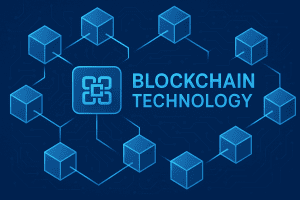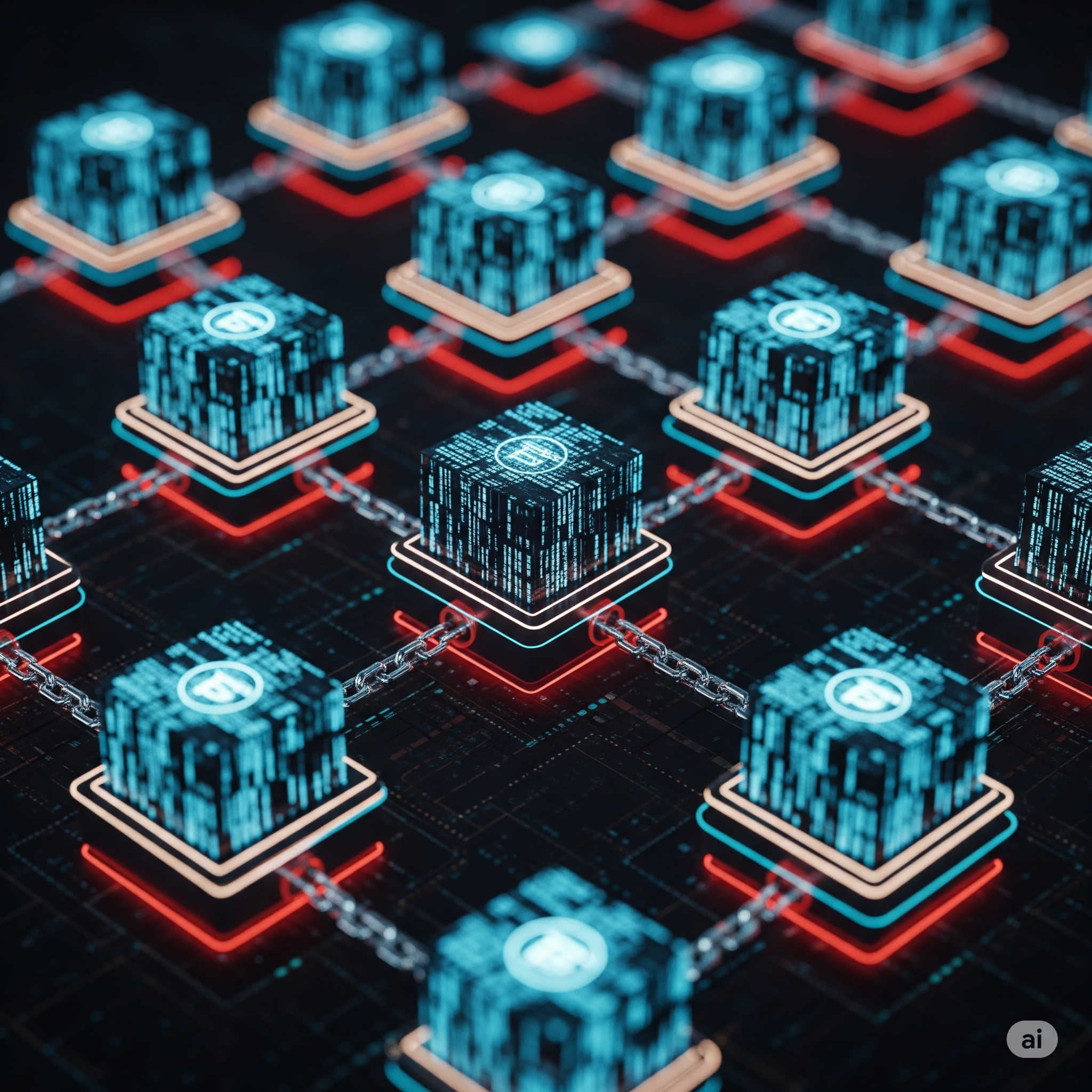Imagine verifying land title deeds or sending school fees from the diaspora instantly. Envision a world where every transaction, record, and agreement is tamper-proof, transparent, and instantly verifiable—without needing a central authority. This isn’t science fiction; it’s the foundational promise of blockchain technology in Kenya.

What is a blockchain?
A blockchain is a shared immutable ledger enabling the record of transaction and tracking of digital assets within a business network. A blockchain database stores data in blocks which are then linked together in a chain. The data is chronologically consistent because you cannot modify or delete data without the consensus of the network. Blockchains are fundamental to cryptocurrencies, ensuring secure and verifiable transactions. They can be used to make data in any industry immutable meaning the data cannot be altered with.
Unlike traditional databases, blockchains are managed by a network of computers (nodes) that validate and record transactions. No individual or organization controls the data. The key benefit of blockchain technology in Kenya lies in its ability to enhance transparency, security, and trust, especially in areas traditionally dominated by intermediaries like banks and brokers. It holds promise for sectors like land registry, health records, and mobile payments. They also help in improving efficiency and cost by enhancing accountability.
The evolution of blockchain
Blockchain technology began with the introduction of bitcoin in 2008, by Satoshi Nakamoto. The blockchain served as a ledger, safeguarding transactions and securing records, a key issue in digital currency at that time. With the development of other currencies like Ethereum in 2015, blockchain started to support smart contracts and this broadened real-world application of blockchain. It extended in use for areas like finance, health and the voting system. With time blockchain has grown beyond cryptocurrency and is becoming a key player in decentralised finance (DeFi) and non-fungible tokens (NFTs). Blockchains continue to evolve with technologies such as Artificial intelligence (AI) and the Internet of Things (IoT).
Blockchain technology in Kenya has evolved rapidly from early experimentation with cryptocurrencies around 2014 to becoming a key driver of innovation across multiple sectors today. Initially embraced by fintech startups inspired by the success of mobile money platforms like M-Pesa, blockchain technology in Kenya has expanded its applications to include cross-border payments, supply chain transparency, land registry and digital identity solutions.
Between 2017 and 2020, the country saw a surge in blockchain startups and pilot projects, which sparked growing interest from financial institutions and regulators. More recently, both the government and private sector have collaborated on blockchain technology in Kenya initiatives aligned with the nation’s Vision 2030, aiming to harness the technology for economic growth and improved governance in the country. Despite some challenges such as regulatory uncertainty and infrastructure gaps, blockchain technology in Kenya continues to develop a vibrant ecosystem driven by a young, tech-savvy population,digital literacy and increasing digital connectivity.
How it works
Blockchain technology records data by lining data blocks together. Each block contains crucial information about the movement of digital assets. Here is a more detailed explanation of how it works.
1) Record transactions
Each transaction made is recorded as a block and it shows the movement of physical or digital assets from one party to another in a blockchain network. Each block contains a timestamp which records the exact time each transaction took place. The timestamp ensures that the transaction took place chronologically. The details recorded here include
- Who was involved in the transaction.
- Where did the transaction occur.
- When did the transaction occur.
- What happened during the transaction.
- Why did the transaction occur.
- How much of the assets was exchanged.
- How many pre-conditions were met during the transaction
2) Gain consensus
Most participants in the blockchain must agree that the transaction record is valid. Rules of agreement can vary depending on the type of network but are mostly established at the start of the network. The rules of agreement are called consensus mechanisms.
Two common consensus mechanisms are:
i) Proof of Work (PoW): (Used by Bitcoin) Nodes (called “miners”) compete to solve complex cryptographic puzzles. The first one to solve it gets to add the new block to the chain and is rewarded. This “work” makes it computationally expensive and difficult to manipulate the network. This process is energy-intensive, making it difficult and costly to attack or manipulate the network.
ii) Proof of Stake (PoS): (Used by Ethereum 2.0) Validators are chosen to create new blocks based on the amount of cryptocurrency they “stake” (hold as collateral) in the network. This incentivizes honest behaviour.
3) Linking the blocks together
Each block is linked to the previous block and the other after it. This creates a secure chain of data. This is done through cryptographic hashes are appended to the new block acting as a chain that links blocks together. If the block’s content changes intentionally or unintentionally, the hash value changes providing a way to detect data tampering and malicious actions could result in the loss of staked funds.
4) Building an irreversible blockchain
The blocks are grouped together in an irreversible chain known as blockchain; each additional block strengthens the previous block and therefore strengthens the whole blockchain. This makes the blockchain secure from malicious actors who may try to insert fraudulent transactions into the chain.
5) Upholding trust, transparency and immutability
The immutability provides a transparent and trusted ledger that all participants can rely on to secure the transactions preventing fraud and transactions that cannot be changed.
6) Share the ledger
All participants receive the latest copy of the central ledger from the system.
Types of blockchain network
There are four main types of distributed networks in the blockchain. They include
i) Public blockchain network
These are open and permissionless blockchain networks, meaning it allows anyone to join. Examples of these are Bitcoin, Ethereum and Litecoin blockchain. All participants have equal rights to read, edit and validate the blockchain. However , it also comes with drawbacks which includes high computational power requirements, lack of transaction privacy and potential weaker security.
ii) Private blockchain network
Also called managed blockchain, they are permissioned and restricted, typically used within an organisation or by selected participants. A single organization governs the entire network controlling who is allowed to participate and what rights they have in the blockchain. Private blockchain networks are partially decentralised because they have access restrictions. It can be run behind a corporate firewall and be hosted on premises. A Good example of this blockchain is Ripple, a digital currency exchange network.
iii) Hybrid blockchain network
These blockchain combine the elements of both public and private blockchain allowing selective transparency and customizable access level. In This way they control access to specific data stored in the blockchain while keeping the rest of the data out to the public.
iv) Consortium blockchain network
This is a semi-decentralized blockchain governed by a group of organizations who share the responsibility of maintaining the blockchain. The control who can submit transactions and access data. Organizations who share a common goal can benefit from this type of blockchain. Examples of such organizations that use blockchain technology in Kenya are the energy sector and the shipping industry.
Blockchain protocols and platforms
The term blockchain protocol refers to a set of rules that govern how data is received, shared and stored within a blockchain network. Each protocol defines how participants reach consensus, how transactions are validated and how security is maintained. Here’s a list of common blockchain protocols and platforms:
- Hyperledger Fabric
- Ethereum
- Quorum
- Corda
-
Hyperledger fabric
Hyperledger Fabric, an open-source project by the Linux Foundation, offers a modular architecture ideal for enterprise blockchain applications. It supports use cases such as supply chain traceability, trade finance, and digital identity verification.
-
Ethereum
Ethereum is a decentralized open-source blockchain platform that allows developers to build and deploy public blockchain applications. It is specifically designed for business blockchain applications.
-
Quorum
An open-source blockchain permissioned protocol based on Ethereum designed for private blockchains. It supports features like transaction privacy and fast consensus mechanism. This makes it a good pick for the financial institutions where confidentiality is crucial.
-
Corda
A distributed ledger platform designed to enable secure and private transactions on private blockchains. It allows organizations to share and execute agreements with the relevant participants making it ideal for financial, healthcare and supply chain management.
Here is where blockchain platforms come in, offering infrastructure and services to create and run apps within the blockchain network. While protocols define the main functionality, these platforms enable development of practical solutions therefore extending the functionality. Blockchain protocol and platforms overlap as platforms rely on specific protocols to carry out their operation.
How are blockchains in Kenya used
Blockchains in Kenya are being used in innovative and practical ways across various sectors in the country. Here’s an overview of how blockchains are applied in Kenya:
1. Financial services and payment
Blockchain is used for crypto transactions to lower cost, reduce delays associated with traditional money transfer services and avoid any intermediaries. Some of these transactions include
- Bitcoin
- USDT
- Remitance
- Decentralized finance (DeFi)
2. Agriculture and food supply management
Startsups and NGOs use blockchain in Kenya to track the food produce from the farm or main origin to the market. This improves honesty and transparency, thus reducing fraud and easy when it comes to verifying claims.
3. Land and property registration
Blockchain is being tested to reduce land fraud and disputes by creating tamper-proof digital land records, ensuring transparency in land transactions. This will enhance transparecy, reduce fraud and provide digital records to both parties. The Ministry of Lands has piloted blockchain-based registry systems to digitize and secure land titles, reducing fraud and disputes.
4.Energy sector
Blockchain-based platforms have been established in various parts of the country to allow households with solar panels to trade excess electricity with neighbors directly, without a central utility.
Pros and cons of blockchain technology in Kenya
| Pros | What It Means | Cons | What It Means |
|---|---|---|---|
| Decentralized | No single person or company controls it. Run by many users worldwide. | High Energy Use (Some Chains) | Bitcoin and others (using Proof of Work) consume a lot of electricity. |
| Secure | Data is hard to change once added. Helps prevent fraud and hacking. | Scalability Issues | Blockchains can slow down or become expensive with too many users. |
| Transparent | Public can view transactions, increasing trust and accountability. | Irreversible Transactions | Once confirmed, transactions can’t be undone—even if made by mistake. |
| Fast Transactions | Some blockchains allow quick cross-border money or data transfers. | Can Be Complex | Beginners may find blockchain systems difficult to understand and use. |
| Low Fees | Generally cheaper than banks or traditional financial systems. | Regulation Unclear | Laws around blockchain and crypto are still evolving in many countries. |
| Smart Contracts | Self-executing code automates agreements, reducing need for middlemen. | Private Keys Can Be Lost | If you lose your private key, you could permanently lose access to your crypto. |
| Open 24/7 | Always online—no downtime like banks or institutions. | Some Blockchains Are Slow | Older chains like Bitcoin may take minutes to confirm a transaction. |
Blockchain vs Bitcoin in Kenya
Blockchain and Bitcoin are closely related but fundamentally different concepts. The concept of blockchain technology in Kenya goes beyond cryptocurrency. It’s seen as a transformative technology for public recordkeeping, supply chains and digital identity verification. Blockchain is a decentralized digital ledger technology that records and verifies transactions across multiple computers in a secure, transparent and tamper-proof manner. It serves as the underlying foundation for various applications, including cryptocurrencies, supply chain management, healthcare systems, and voting platforms.
On the other hand, Bitcoin is the first decentralized digital cryptocurrency to enable peer-to-peer transactions that operates on blockchain technology without a central authority. Launched in 2009 by an anonymous person or group known as Satoshi Nakamoto, Bitcoin was the first practical application of blockchain and is primarily used as a store of value. Bitcoin plays a major role in the blockchain ecosystem. While blockchain is the broader technology that can be adopted across many industries, Bitcoin is one specific use case of that technology. In simple terms, blockchain is like the internet—a foundational technology. Bitcoin is like email—a specific application built on top of it.
Blockchain and AI
Combining blockchain and AI creates a wide range of opportunities for various industries. They are two of the most transformative technologies of our time and while they serve different purposes, their integration offers powerful possibilities. When combined, blockchain can enhance AI by ensuring traceability and integrity of data. Since AI relies heavily on large amounts of data, using blockchain can help verify that the data is trustworthy, unaltered, and sourced ethically. In the healthcare sector, it analyses data for patients for personalized treatments and blockchain solutions thus ensuring security of medical records and privacy.
Together, blockchain and AI can build systems that are not only intelligent but also transparent, secure and trustworthy, offering significant advancements in fields like supply chain management, cybersecurity, digital identity and more fields. When discussing AI in Kenya, integrating it with blockchain technology in Kenya offers promising applications, from secure health data sharing to ethical machine learning powered by verified, local data sources.
Blockchain as a service (BaaS)
Blockchain as service (BaaS) is a cloud-based service that allows businesses to build, host and manage blockchain applications and smart contracts without having to set up and maintain their own blockchain infrastructure. All you have to do is customize the existing blockchain making it faster and more efficient. Blockchain as a Service (BaaS) in Kenya is making it easier for businesses to adopt blockchain technology in Kenya without building complex infrastructure from scratch.
BaaS platforms like AWS, Microsoft Azure, and IBM allow companies to develop, host, and manage blockchain applications in a cost-effective and scalable way. As interest in blockchain technology in Kenya continues to grow, BaaS is enabling faster innovation across sectors like finance, agriculture, logistics and healthcare. Kenyan fintech companies are beginning to explore BaaS for faster digital onboarding and fraud prevention.
AWS blockchain services
AWS Blockchain Service, primarily through Amazon Managed Blockchain, allows businesses to easily create and manage scalable blockchain networks using popular frameworks like Hyperledger Fabric and Ethereum. It provides purpose-built tools to support your requirement. It eliminates the need to set up and maintain complex infrastructure by providing a fully managed environment that handles provisioning, network setup, scaling and security. AWS also offers Amazon QLDB (Quantum Ledger Database) for applications that need a centralized, cryptographically verifiable transaction log.
These services integrate seamlessly with other AWS tools and offer high security, making them suitable for a wide range of use cases such as supply chain tracking, financial transactions, digital identity, and asset management. AWS Blockchain Service helps organizations adopt blockchain technology faster and more cost-effectively without requiring deep technical expertise. As adoption of blockchain technology in Kenya grows, AWS makes it easier to develop solutions for finance, healthcare and supply chains within the country’s evolving digital economy.
FAQs
Can I get a blockchain job in Kenya?
Yes! Roles include blockchain developers, data analysts, smart contract auditors, and project managers.
Is blockchain legal in Kenya?
Yes, but cautiously. While the Central Bank of Kenya (CBK) warns against unregulated crypto trading, it supports blockchain innovation, especially in public service delivery and fintech.
How do I invest in blockchain?
Start by researching blockchain technology and its applications. You can invest by buying cryptocurrencies like Bitcoin or Ethereum, purchasing blockchain-related stocks or ETFs or funding blockchain startups.
How much money do I need to start a blockchain?
Ethereum or Binance Smart Chain may cost $5,000–$20,000. Starting your own blockchain can cost anywhere from a few thousand to several hundred thousand dollars, depending on complexity. Building a blockchain from scratch can exceed $100,000 due to development, security and infrastructure requirements.
Where is blockchain used in real life?
- Supply Chain: Tracking products from farm to store, ensuring authenticity and safety.
- Healthcare sector: Securely managing patient records and tracking medication origin therefore enhancing privacy.
- Finance: Speeding up international payments and simplifying trade finance.
- Digital Identity: Giving individuals more control of access over their personal data.
- Real Estate: Streamlining property ownership records and transactions.
- Digital Art: Proving unique ownership of digital items (NFTs).
Conclusion
As Kenya advances its digital agenda, blockchain technology is poised to revolutionize public services, financial systems, and business operations. With the right investment in skills, infrastructure, and regulation, Kenya could emerge as a blockchain leader in Africa—fostering transparency, accountability, and inclusive growth.
However, for blockchain adoption to scale in Kenya, there must be increased awareness, supportive regulation and investment in local talent and infrastructure. Education and innovation hubs must play a key role in nurturing blockchain developers and thought leaders. If embraced strategically, blockchain technology in Kenya could drive inclusive growth, promote accountability and position the country as a leader in Africa’s digital economy. The revolution has already begun, now it’s up to stakeholders, both public and private, to unlock blockchain’s full potential for the benefit of all Kenyans.

